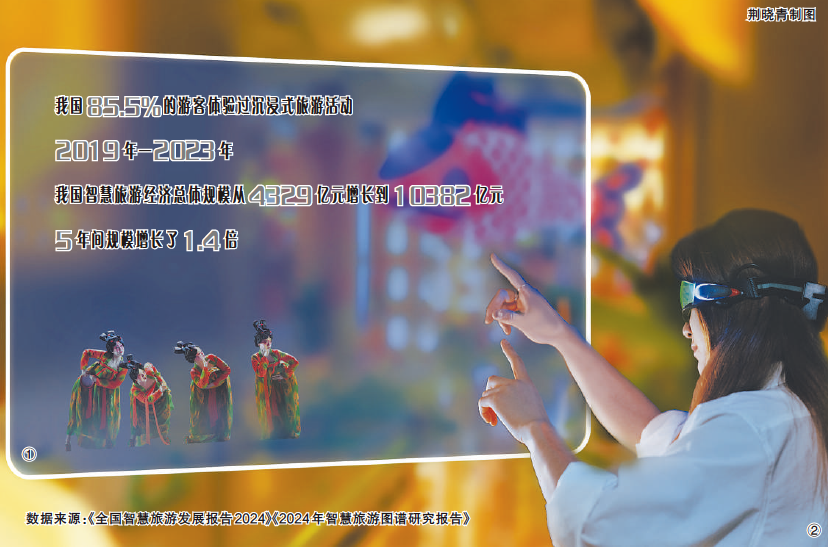This year's government work report proposed to unleash the consumption potential of culture, tourism, and sports.
The metaverse, which integrates the digital and physical worlds, is unlocking new cultural tourism consumption scenarios one by one.
Shanghai has created a metaverse cultural tourism private board meeting, digitizing historical landmarks such as Yu Garden and the Bund. Tourists can "time-travel" to Republican-era street scenes through virtual reality (VR) technology; Gansu has developed an augmented reality (AR) tour system based on Dunhuang murals, allowing tourists to interact with flying apsaras murals by scanning codes; Beijing has seized the opportunity of the renovation and reconstruction of the Workers' Stadium to create the Workers' Stadium Metaverse Center, launching "Digital Football" and Workers' Stadium Metaverse live broadcasts, where tourists can transform into "digital goalkeepers" in the metaverse space and engage in penalty shootouts with international top star digital humans...
By reconstructing time and space through digital technology, transforming cultural and sports resources into interactive consumption assets, the metaverse is unleashing infinite potential in the cultural tourism industry.
 Fig. 1: "Tang Palace Night Banquet" stage photo. Photo by Xinhua News Agency reporter Li Jianan / Fig. 2: A girl using VR glasses. Photo provided by Visual China
Fig. 1: "Tang Palace Night Banquet" stage photo. Photo by Xinhua News Agency reporter Li Jianan / Fig. 2: A girl using VR glasses. Photo provided by Visual China
Entering the Industrial Explosion Period
In the past year, new forms of immersive experiences represented by large-scale location-based entertainment (LBE) venues in the metaverse have become popular worldwide. Whether it’s France's "The Vanished Pharaoh" or China's "Tang Palace Night Banquet," they have left consumers in awe.
At Beijing, a science and technology daily reporter experienced the country's first large-scale mixed-reality immersive interactive experience project, "The Sleeping Ancient Castle." Wearing VR glasses, the coordinates on the floor and walls of the passage turned into cliffs, while the handrail on the right merged with the virtual scene, helping players establish a sense of security before the adventure began.
"The Sleeping Ancient Castle" was designed based on Zhangbi Village, an ancient village in Shanxi. Zhangbi Village is an ancient underground military fortress, known for its "visible fort above ground and hidden tunnels below ground," with the most famous being two peacock blue glazed steles made during the Wanli period of the Ming Dynasty. Players can follow non-player characters (NPCs), appreciate film-level special effects that blend ancient castle real scenes with virtual scenes in the storyline, and embark on a mysterious journey.
In the past, it was difficult to set up network environments suitable for immersive interactive experience projects in large spaces covering thousands of square meters. Traditional local area networks were limited by coverage area and channels, making it hard to meet the needs of VR e-sports for multi-terminal concurrency, real-time rendering, ultra-large downstream bandwidth, and ultra-low latency.
The "Kernel" 5G private network all-in-one machine jointly developed by China Mobile Communications Group Co., Ltd. Research Institute and Zhongyi Greater Bay Area (Guangdong) Innovation Research Institute successfully addressed the shortcomings of traditional local area networks in large space application scenarios.
In the equipment room, the reporter saw the "Kernel" 5G private network all-in-one machine, which is only the size of a suitcase. "Small but complete," it embeds multiple modules such as a lightweight core network, 5G small base stations, and edge applications, capable of quickly setting up a 5G private network covering a radius of two kilometers. Its average upstream speed is 400Mbps, downstream speed is 800Mbps, providing stable 35Mbps speed and less than 20 milliseconds transmission delay for multiple VR terminals simultaneously, supporting up to 20 players exploring the "castle" at the same time.
Li Wenguo, account manager of China Mobile Communications Group Beijing Co., Ltd., introduced that "The Sleeping Ancient Castle" is the debut application of "Kernel" in large-scale mixed-reality immersive technology scenarios. In the future, 5G local area private networks will become important basic resources for the "metaverse + cultural tourism industry."
Large-scale immersive LBE projects in China are rapidly entering the industrial explosion period. "Rising Wind in Luoyang," "Tang Palace Night Banquet," "Awakening Qin Tide," "Terracotta Warriors Wonderful Night," "Wind Rising Over Yue Song," "Three-Body Problem: Gravity Outside," "China Roaming: Beijing Central Axis," "Hidden Qin Mausoleum"... More than 200 large-scale immersive LBE projects based on original IPs have been put into operation nationwide. Currently, the average ticket price for large-scale immersive LBE projects is over 100 yuan, with each experience lasting about 45-60 minutes. Industry data shows that by 2026, the overall scale of China's large-scale immersive industry is expected to exceed 250 billion yuan.
Creating New Consumption Experiences
The "Three-Year Action Plan for the Innovative Development of the Metaverse Industry (2023-2025)" (hereinafter referred to as the "Action Plan") jointly issued by the Ministry of Industry and Information Technology and other five departments proposes that by 2025, typical software and hardware products of the metaverse will achieve scale application, forming a number of new businesses, models, and formats in life consumption and public service fields.
As the "metaverse + cultural tourism industry" accelerates its implementation, many domestic scenic spots are shifting from sightseeing tourism to experiential tourism, creating new consumption scenarios and extending industrial chains. The virtual cultural tourism scenes created by metaverse digital technology, which are available around the clock and touchable, break the boundaries of time and space, making more and more young people fall in love with "two-dimensional" travel.
"We have built a digitally-real fused, experience area exceeding 30,000 square meters at the Beijing Workers' Stadium Metaverse Center," said Ge Qi, Vice President of Zhonghe Group and founder of the Workers' Stadium Metaverse. This is the world's first new B2C mixed-reality Internet 3.0 social platform based on large-scale sports, culture, and commercial entity projects. Less than three months after opening, the Workers' Stadium Metaverse Center welcomed thousands of visitors, experiencers, and testers.
Ge Qi said that in the past year, new businesses and technologies such as 5G-A and hybrid artificial intelligence have entered the metaverse industry, allowing more consumers to enter the metaverse space through ubiquitous, low-cost, and highly reliable 5G networks. At the same time, hybrid rendering methods allow expensive and complex digital assets to be reflected on extended reality (XR) terminals in a separated rendering mode at a lower cost.
If the Workers' Stadium Metaverse largely expands the entertainment space for football fans, then the Blue Harbor Consumption Metaverse has become a consumer paradise for young people. As another metaverse benchmark application scenario created by Chaoyang District of Beijing, the Blue Harbor Consumption Metaverse integrates shopping, socializing, and entertainment functions. Consumers only need to log in to the App to instantly transform into digital humans, "teleport" to Blue Harbor from home, learn about the latest discount activities and seasonal hot new products, and even share good finds with friends. Discount coupons obtained by participating in fun games can also be used in offline stores.
With the support of new technologies, the metaverse will land in more scenarios, entering various aspects of public production and living, as well as social governance.
Tackling Technical Pain Points
Currently, a diversified, multi-level metaverse industrial ecosystem is being constructed globally, encompassing a diverse combination of general-purpose large models, industry-specific large models, and specialized large models.
Ge Qi believes that artificial intelligence will push Internet 3.0 towards the high ground of the metaverse, and the metaverse is expected to become the main form of the next-generation immersive Internet 3.0.
For example, advanced AI algorithms can automatically generate complex and realistic virtual environments, including terrain, buildings, vegetation, etc., greatly reducing the cost and time of creating virtual worlds; AI-driven NPCs can exhibit more natural behaviors and dialogue capabilities, enhancing users' immersion and interactive experience in the virtual world; AI can also achieve real-time multilingual translation in the virtual world, breaking language barriers and promoting global user communication and interaction...
However, to build ubiquitous, universal, and seamless metaverse spaces and construct advanced metaverse technology and industrial systems, further efforts are needed to resolve bottlenecks and eliminate pain points.
Regarding the construction of the metaverse industry, Ge Qi summarized the current three major technical pain points: First, the hardware devices relied upon by metaverse applications or platforms have insufficient storage capacity or processing power, making it difficult to achieve true digital-real linkage and fusion; Second, the development cost of metaverse application system solutions is high, the operation cycle is long, and Wi-Fi streaming solutions have poor system performance and low concurrency numbers, making it difficult to meet the needs of smooth multi-event operations; Third, XR devices do not support eSIM (embedded SIM card) technology, and 3D digital assets cannot be broadcasted and operated across hardware, platforms, and physical spaces.
Ge Qi further analyzed that the main form of Internet 3.0 centered on the metaverse places higher demands on super-strong access capabilities, which Wi-Fi obviously cannot meet. 5G-A and millimeter-wave new generation 5G networks with greater traffic density will become standard equipment for the metaverse. The peak rate of 5G-A in actual network tests can reach 6.1Gbps, with an average rate of 3.4Gbps, empowering full-scenario communication and rendering applications in the metaverse and improving user experience.
"Multi-form XR terminals are expected to become the 'killer' hardware applications of the new generation of 5G networks," said Ge Qi. If eSIM empowers XR devices, it will give them revolutionary functions, supporting the application of various smart hardware such as smartwatches and smartphones in the metaverse.
The policy direction for promoting the construction of advanced metaverse technology and industrial systems is very clear.
The "Action Plan" addresses the bottleneck issues of weak core technologies, insufficient product variety, and small industrial scale in China's metaverse development, proposing to further strengthen the integration and innovation of artificial intelligence, blockchain, cloud computing, virtual reality, and other technologies in the metaverse, accelerate the layout of key technologies, and expedite the research and innovation of basic software and hardware, achieving breakthroughs in key directions such as high-end electronic components and modeling software as soon as possible; regarding metaverse product supply, it proposes focusing on real-world needs such as socializing, entertainment, and office work, emphasizing efforts on metaverse entry points, virtual space application tools, and platforms.
At the same time, the "Action Plan" advocates strengthening market entities, cultivating leading metaverse enterprises and specialized and refined new enterprises, building a number of metaverse innovative application pilot zones, science and technology parks, and industrial parks, creating characteristic industrial clusters, and exploring new models and formats for user participation in technological innovation and content production.
Ge Qi believes that as the metaverse becomes the main form of Internet 3.0, it will bring users richer, more realistic, and personalized experiences, promoting the innovative development of the digital economy and cultural industries.

